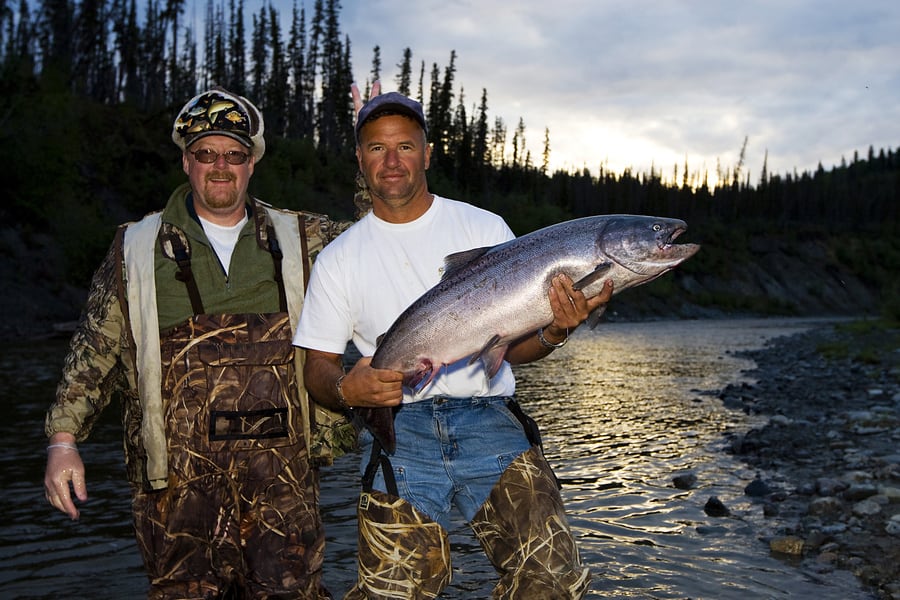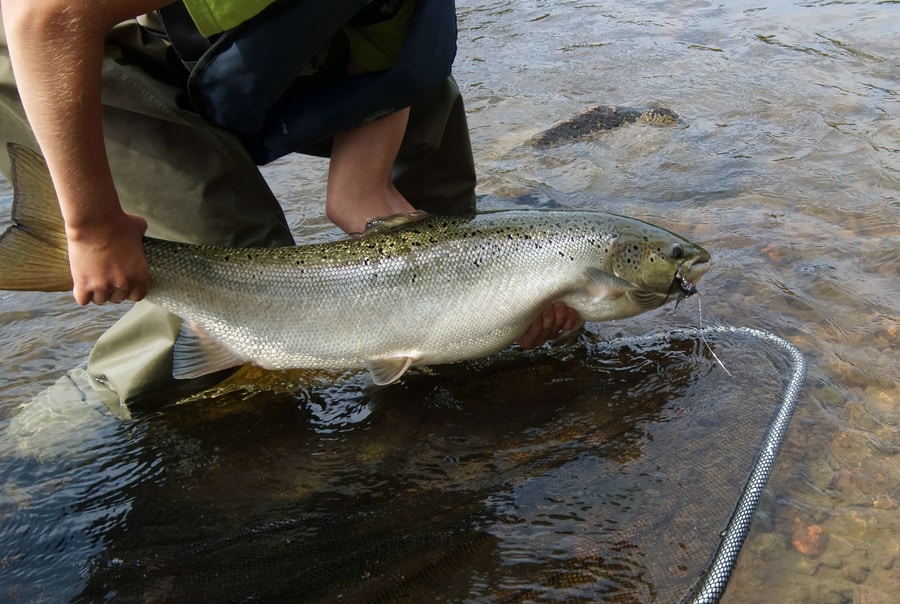Will Salmon Bite at Night? (Moon Phases, Seasons, Baits)

There are 7 species of Salmon in North American waterways and they are incredibly valued targets for fishermen. Most anglers head out in the early morning and late afternoon but the night can seem like a challenging time for most anglers so they avoid this potentially great window.
Salmon fishing can be incredible for most species of salmon (coho salmon excluded) on new and full moon nights around dawn and dusk. The reduced light and cooler temperatures of night fishing can yield great successes for salmon anglers.
Moon phases, seasonality, location, weather, and fishing pressure can all play major roles into how much salmon will bite at night. Additionally, between the species of salmon, their willingness to feed at night can vary dramatically. This article will break down these factors and help better prepare you for catching salmon after dark and what season is best to target them.
I know this is a bit random, but if you ever wanted to go on a guided or chartered fishing trip in freshwater or saltwater, you should check out Fishing Booker. They are the leading database of certified and professional fishing guides at the guaranteed lowest prices. Click here to visit Fishing Booker and book your trip of a lifetime at very affordable prices.
Salmon Species Breakdown
Chinook or King Salmon
The Chinook represents the largest of the salmon and one of the most sought after commercially. The Chinook can be caught at any time of the day, but the last moments of night, as the eastern sky begins to take on a pink glow is the magic time to tie into a king. A close second is the opposite side of the clock from sunset until dusk.
Chinook can be caught in the ocean and as they head back upriver. Spinners, plugs, herring rigged to fish at-depth, or even with bobbers are all good methods of snagging a king salmon. Many anglers troll along the coast with the land barely visible, seeking the perfect water temperature to tie into a “king”.
With a range from the Southern California coast, all the way north to the Alaskan Arctic these monsters that can reach 100 pounds and five feet in length are the most popular species of salmon.
The peak season along the Pacific Coast is from late June to early August with a second season from September to October.
King’s are not native to eastern waters, but they have been successfully transplanted to the Great Lakes. King salmon can be caught at night under the right conditions.
Sockeye Salmon
The sockeye is considered the best-tasting salmon by both bears and humans. Not as big as the Chinook, they are fished a bit differently.
Sockeye lures include flashers, hoochies, squid flashers up to a foot long, sometimes with herring attached as an attractant.
Studies have indicated that Sockeye can see red more than any other color. That is a factor when selecting the right color combination in a lure.
Night fishing for Sockeye can be very rewarding, especially under a full moon. Fishing towards shore from a boat is often the best method. Cast where you would stand if you were wading out to fish from shore. Fishing the shallows where baitfish move close to shore is a good technique.
When Sockeye move into freshwater they don’t feed, but they become extremely aggressive. Try lures that mimic rainbow or brown trout and the nasty disposition of Sockeye moving upriver to spawn can get a strike.
The best season for Sockeye is June to September. They are not as easy to catch as other salmon species. As with all fish, check local regulations before you assume you know what is and what is not allowed.
Regulations vary greatly from state to state and into the provinces. They vary on specific waterways as well. These fish will bite at night under full moons.
Coho or Silver Salmon
If you’re looking for a good fish to try at night, you’ll need to go elsewhere. Coho are much easier to catch during daylight. You can have luck in the pre-dawn hours as the light begins to arrive.
Coho are not as large as Chinook, but they are the warriors of the salmon world when it comes to fighting. Coho are the salmon equivalent of the hard-fighting rainbow of the trout world. Coho will test your drag, snap your line and almost always save a final lunge just as you get them near the net.
Coho have a different life cycle than other salmon. They spend one to two years as juveniles in freshwater before venturing out to seas.
Florescent red, orange, and chartreuse plugs work best with Coho. They are a northern fish, with numbers beginning along the Oregon coast and extending north into Alaskan waters. May to June often offers good Coho fishing, but so does a later season from late July to December.
Chum or Dog Salmon
The Chum is the ugly step-sister of the salmon world. Not as popular as the other species, Chum tastes different than other salmon. Female Chum are more popular than their male counterparts as a source of caviar often served with sushi.
Chum feed near the surface on baitfish. Lures that resemble baitfish work the best. Night fishing is productive, once again best with a full moon in water less than 60 feet deep.
Plastic flashers work well in ocean water. Chum attack lures in freshwater to defend themselves. Throw a spinner or spoon close to them and you’ll likely get a strike. They are a late-season fish, with a season from September to December.
Pink Salmon
Pinks are the smallest species of salmon, ranging from 18 to 30 inches. They are an aggressive fish, that tastes great in spite of their smaller size.
Pinks are best fished like bass in freshwater. Cast a buzz bait, crank a bit, jerk the lure a little, and these aggressive fish will hit hard.
They’re best in late summer and one of the easier species to catch in freshwater. They’ll hit on a pink rotating lure, a pink plastic squid, or a hoochie.
You’re best luck for Pink salmon comes during the day, but they’ll hit in those magic hours just after sunset and just before sunrise. Fishing in the dead of night is normally a waste of time.
Pink salmon have a unique spawning cycle long the Washington and British Columbia coast, only moving into freshwater to spawn every other year. They spawn in odd-numbered years outside of Alaska.
For a complete breakdown of which fishing bite best at night, please check out this helpful article I wrote.
Kokanee
Kokanee are landlocked freshwater Sockeye that have been planted across the North American continent. You can find them as far inland as Wyoming, and Colorado. While they don’t partake in the ocean-going life cycle, they are true salmon.
Kokanee are possibly the best species for night fishing. They will feed aggressively at night, especially on full and new moon nights. Best fishing times are dawn and dusk. You can catch Kokanee in lakes across the continent at any time of the year, but night fishing is usually best in July.
Fishing for Kokanee is much like walleye fishing. They make very soft strikes. An inexperienced angler can easily miss these subtle hits.
Glow worms, plastic worms, along with bullet head sinkers and light test line, less than 12-pounds work best for detecting the light strike of a Kokanee.
Hooks arranged above a bell sinker on the bottom work well. Kokanee are bottom level fish, that like to stay just a few feet on the bottom.
Worms, mealworms, and other live bait don’t work well with Kokanee. Kokanee are easy to spot with a fish finder. Make appropriate adjustments for depth and you’ll have good luck.

Atlantic Salmon
Atlantic salmon are unique among natural salmon, they don’t spawn and die, but return to the ocean after spawning. It is counterintuitive to our vision, but the darker the bait, the easier it is for Atlantic salmon to see it.
Atlantic salmon have vastly different vision than humans. They see more in the ultra-violet range than we can. Atlantic salmon see better at night than they do during the day. The best Atlantic salmon fishing in the Great Lakes is almost always at night. Violet and dark violet lures are the best for night fishing.
The best season for Atlantic salmon is late summer, from August to September. Atlantic salmon are nearly as large as Chinook but fight as hard as Coho.
They have been fished to extinction in much of their natural range. They can still be found offshore from Connecticut north into Canada.
The Great Lakes and remove rivers along the Northeast Atlantic coast are the best locations to find Atlantic salmon. American and Canadian regulations are very specific on size, possession, and catch-and-release with Atlantic salmon. Know the rules before you venture out.
Basics of Salmon Fishing & Nighttime
While specific waters and specific species may vary, generally the best season for salmon fishing is in the fall. Late summer offers good luck. The spring is better for related species such as Steelhead, brown, and rainbow trout.
These fish are often hungry after long winters devoid of insects to feed on. Night fishing can be good for most salmon except for cohos, especially on new and full moon nights. You’ll want to fish hard around dawn and dusk as these are the hottest bites.
Winter is usually the worst time to fish for salmon. It can’t be stressed enough to pay attention to the regulations associated with the water you are fishing and the type of salmon you’re after. Rules vary greatly, sometimes in just a few miles.
Best Time of Day for Salmon
In general, the magic hours of early morning just before sunrise, and late evening just after sunset are the best for salmon fishing. The phases of the moon come into play, high and low tide, and even low-pressure systems moving in can enhance your opportunity.
The best fishing reported by many anglers comes during a rainstorm. Raindrops rippling the surface of the ocean, river, or lake can often produce sudden surges of salmon strikes.
The moon has a definite impact on all types of night fishing. Not only does it illuminate lures in the water, but the moon also regulates tides. The best moon phases for salmon are often the 3 or 4 days around the new moon and 3 or 4 days around the full moon.
These time windows are great for day and night fishing. Pay attention to the structure beneath the surface. Play that structure with the rise and fall of the tides and your luck will improve.
No Hard & Fast Rules about Nighttime Salmon
Salmon appear similar but are very different species. Generalizations on night versus day fishing don’t work across the six North American species.
Early morning and late evening are often the best, but some fish will hit well at night, and others during daylight. Generally, the worst time to fish is around noon, during the heat of the day.
Are Salmon at sea more likely to bite at night than freshwater salmon? In general no, they’re not. Some species are best in the ocean, others are just as aggressive when in freshwater.
This means they’ll feed both at night and daytime if the conditions are right. With the notable exception of coho who really stop feeding in darkness.
When knowledge, meets skill, mixed with a bit of understanding and a dash of experience, the salmon will come.
No man ever steps in the same river twice, for it’s not the same river and he is not the same man. Heraclitus 5th century BC Greek philosopher
For a complete breakdown of catching fish at night, check out this guide.
